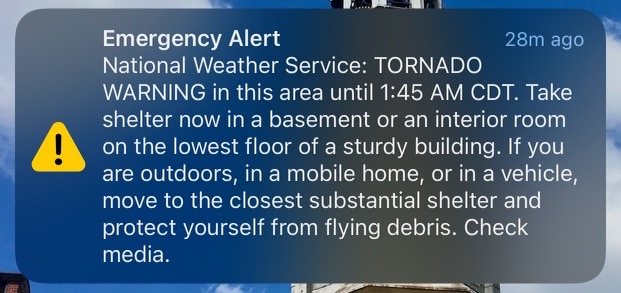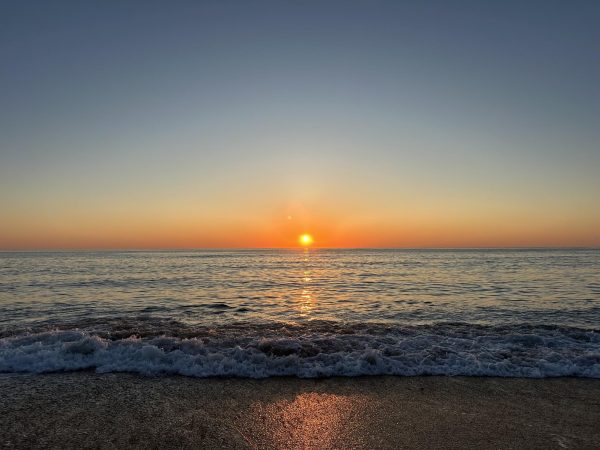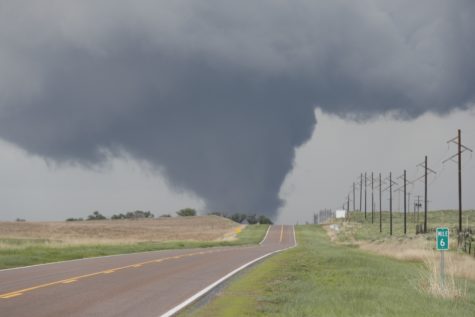Tornadoes: Facts and Safety Tips
Stowellg, via Creative Commons Attribution, via Wikemedia Commons
A tornado warning, as seen on this phone screen. Stowellg. Permission to share under license CC BY-SA 4.0. https://creativecommons.org/licenses/by-sa/4.0/deed.en
Now that tornado season has begun – peak tornado occurrence in the southern United States is from March through May, while peak tornado occurrence in the northern United States is during the summer, though tornadoes can occur year-round – answers to common questions about tornadoes, as well as safety tips, are addressed below.
What’s Tornado Alley?
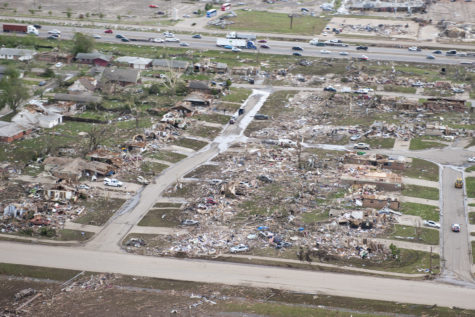
Tornado Alley is an unofficial area of the United States that includes Oklahoma, Kansas, Missouri, as well as parts of Texas, Louisiana, Nebraska, Iowa, and Colorado, in which there is higher potential for tornadic activity because of contrasting air masses that frequently collide, producing violent thunderstorms that have the potential to spawn tornadoes, as explained by AccuWeather, a meteorological service.
Two of the strongest tornadoes in recent American history have occurred in Tornado Alley: the Joplin, Missouri, tornado in 2011, which claimed the lives of 161 people and injured more than 1,300 people; and the Moore, Oklahoma, tornado which in 2013 directly claimed the lives of two dozen people and injured at least 200. The Moore tornado in 2013 is the most recent EF5 tornado in the United States (to learn more about the process by which tornadoes are rated, check out this article.)
What was the Deadliest Tornado in the United States? And do tornadoes form in other parts of the world?
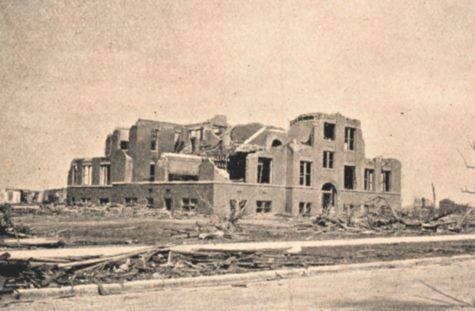
The deadliest tornado in American history is the Tri-State Tornado, which occurred in 1925 and ravaged a 219-mile-long path through parts of Indiana, Missouri, and Illinois. After more than three hours on the ground, killing 695 people and injuring some 2,000 people, the tornado subsided, though its infamy as the deadliest tornado in American history still lives on today.
Perhaps surprisingly, the Tri-State Tornado is not the deadliest tornado in world history. This designation rather goes to the Daulatpur-Saturia Tornado, which struck the Manikganj District of Bangladesh in 1989, killing approximately 1,300 people and injuring an estimated 12,000. Bangladesh has had its fair share of devastating tornadoes – since 1972, five of Bangladesh’s deadliest tornadoes, including the 1989 tornado, have killed about 3,400 people.
It is clear that the United States is not the only country to experience tornadoes. In fact, every continent has experienced tornadoes, except for Antarctica. However, due to the topography of the United States – flat, open plains in the center of the nation – it is especially at-risk for tornadic activity.
What is the difference between a tornado watch and a tornado warning?
A tornado watch is implemented by the National Weather Service when weather conditions are favorable for tornadic activity. A tornado warning is much more serious, because it means that a tornado has been spotted or a weather radar indicates that there is one.
How can I survive a tornado?
Various government agencies and meteorological services outline tips to stay safe during tornadic activity:
- Everyone under a tornado warning should immediately seek safety in a sturdy shelter, such as a storm cellar or basement.
- Most tornado-related deaths occur in mobile homes. If you are in a tornado warning and live in a mobile home, then seek shelter in a sturdier building or in a tornado shelter.
- If you are unable to take shelter in a cellar or basement, then take shelter in an interior room, preferably one without windows or glass, on the lowest level.
- Stay away from glass, doors, and outside walls.
- Use your arms to protect your head and neck – additionally, wearing a bicycle helmet can protect your head from falling debris and blankets and pillows can protect the rest of your body.
- If driving a vehicle when a tornado is present, do not attempt to outrun the tornado; instead, attempt to find shelter in a sturdy building.
- If shelter is not possible to find, then either leave your car and find a low-lying area, such as a ditch, that is away from trees and similar objects that could become projectiles, or buckle your seatbelt and position yourself below the window level of the vehicle.
- Do not take shelter under an overpass: The wind and debris from the tornado could funnel through the overpass, making you more susceptible to injury or death.
Philip is a senior from the Washington, D.C. area. In his free time, he enjoys writing, singing, traveling, and photography.

